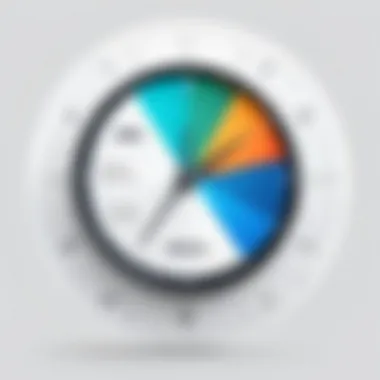Top Time Management Apps for Mac Users


Intro
Time is a slippery thing; it can feel like you’re both racing against and dragging along a heavy anchor. As a Mac user navigating both personal obligations and professional landscapes, effective time management becomes essential. This overview dives deep into some of the best apps available for Mac users. These tools don't just help in logging hours, but they streamline workflows, ensuring that every minute counts. Whether you’re juggling multiple projects or just trying to keep your calendar in check, having the right software can make all the difference.
Managing time efficiently is not merely about keeping a record of tasks but also about enhancing focus, productivity, and decision-making capabilities. As we sift through various applications, expect to find gems that shine because of their unique features, intuitive interfaces, and reasonable pricing plans tailored for professional environments.
Key Features
Overview of Core Features
When selecting a time management app for your Mac, understanding its core functionalities is paramount. Here are some common features that many leading applications offer:
- Task Management: Some apps let you create, prioritize, and track tasks seamlessly. An example would be Todoist, known for its straightforward task assignment and categorization.
- Time Tracking: Applications like Toggl allow you to record how much time is spent on each task, enabling more accurate assessments of productivity.
- Calendar Integration: Efficient coordination with Google Calendar or Apple Calendar can help users stay current with appointments and deadlines.
- Team Collaboration: Tools such as Trello focus on teamwork, offering boards and cards that can be shared among users for collaborative projects.
- Analytics and Reporting: Certain apps provide metrics that showcase how tasks and projects evolve over time. This feature is invaluable for businesses aiming to optimize their workflow.
By incorporating these features, these applications strive to address the common bottlenecks faced by professionals today.
User Interface and Experience
The user interface (UI) of a time management tool greatly influences ease of use and overall satisfaction. Most Mac users prefer a clean, minimalistic design that promotes efficiency rather than clutter. The best apps typically feature:
- Intuitive Layouts: Easy navigation facilitates quick task additions and edits, allowing users to focus on what matters.
- Customizable Dashboards: Users appreciate the ability to personalize their experience, whether by color-coding tasks or rearranging widgets for priority visibility.
- Responsive Design: Ensuring the app works seamlessly on various devices—be it MacBooks, iMacs, or even iPads—is crucial for ongoing usability.
The overall experience should feel smooth, fostering a seamless transition between daily tasks and long-term projects.
Pricing and Plans
Overview of Pricing Models
Pricing can heavily influence the choice of a time management app. Many apps offer tiered pricing structures that cater to different needs and budgets. Here’s a glance at common pricing models:
- Freemium: Apps like Trello offer basic features for free, but users pay for premium functionalities. This model attracts users who want to test the waters before committing financially.
- Subscription-Based: Most apps operate on a monthly or yearly subscription basis, allowing users to choose plans based on their budget and usage frequency.
- One-time Purchase: Despite being less common, some applications charge a one-time fee, a model that appeals to users looking to avoid recurring costs.
Comparison of Different Plans
Understanding the variations in pricing helps in making the right choice. For instance, OmniFocus can come with a hefty price tag but offers features robust enough to justify it for business professionals who prioritize high-level project management.
In contrast, TickTick offers competitive pricing without compromising on essential features, making it suitable for freelancers or small business owners. Here is a synopsis of key comparisons:
| App | Free Plan | Starting Price (Monthly) | Key Features | | Todoist | ✓ | $3 | Task management, reminders | | Toggl | ✓ | $10 | Time tracking, reporting | | Trello | ✓ | $10 | Boards, cards, integration | | OmniFocus | ✗ | $39.99 (one-time) | Robust project management, organization| | TickTick | ✓ | $2.99 | Task management, Pomodoro timer |
Ultimately, selecting the right app boils down to aligning features with your specific needs, budget, and workflow.
"It's not about having time, but making time. The right tools can transform how we approach our day."
In the next sections, we will explore detailed feature sets, user feedback, and the most popular apps currently available, ensuring you get the insights required to choose wisely.
Prelude to Time Management on Mac
In today’s fast-paced world, effective time management has become less of a luxury and more of a necessity. For Mac users, who often engage in a multitude of tasks at once, managing time effectively can translate into improved productivity, reduced stress, and a more organized work process. This section sheds light on why mastering time management is crucial, especially in a tech-driven environment like that of the Apple ecosystem.
Importance of Time Management
Time management is the fine art of allocating one's hours wisely. It’s not just about filling your calendar to the brim; it’s about doing it in a manner that maximizes efficiency. When Mac users take control of their schedules, they often see a direct correlation to their productivity levels. For instance, a well-set timeline can help in breaking down big projects into manageable tasks, thus making daunting goals feel more achievable.


The benefits of proper time management extend beyond just work efficiency. By ensuring that tasks are prioritized and deadlines are met, individuals can carve out more time for family, hobbies, or simply unwinding. Moreover, it fuels a sense of accomplishment that can motivate users to take on new challenges. In essence, mastering time management is akin to crafting a blueprint for one's daily accomplishments, ensuring a structured approach towards both professional and personal responsibilities.
Challenges Faced by Mac Users
Though Mac users are often equipped with sophisticated technology, they aren’t immune to time management hurdles. One major challenge is the allure of the multiple features and applications available; it's easy to get sidetracked by the latest app or tool that promises productivity improvements but ultimately adds to the distraction.
Additionally, the integration between various platforms and tools can lead to fragmentation. For instance, if someone is using different apps for project management, communication, and scheduling, it may result in misalignment and chaos rather than clarity.
"If a task is not tracked, it doesn’t exist." The reality is, for many Mac users, without a disciplined system in place, tasks can easily slip through the cracks.
Finally, with the pervasive presence of notifications and updates, focusing on what truly matters becomes a battle. Sorting through the noise to prioritize daily activities is essential, yet remains a perpetual obstacle.
By understanding these challenges, Mac users can better appreciate the necessity for robust time management applications tailored to streamline their workflow. The right tools promise not just to alleviate these pain points but to create a more coherent and efficient work environment.
Criteria for Selecting Time Management Apps
When it comes to picking a time management app for your Mac, the array of options can seem dizzying. You might find yourself standing at a crossroads, trying to choose between a multitude of features and functionalities. This section aims to shed light on the vital criteria for selecting the best time management software that fits personal or professional needs. It’s more than just a question of preference; the right tools can directly influence productivity, project success, and even work-life balance.
User Interface and Experience Considerations
The first thing that grabs attention is how the app looks and feels. A clean, intuitive user interface can make all the difference in how easily you adapt to a new tool. For instance, if the dashboard is cluttered or confusing, you might find yourself wasting precious time just trying to figure out where things are. Simplicity is the name of the game here. Look for apps that allow for easy navigation and a pleasant visual experience.
- Clear layouts and logical navigation paths are essential.
- Customization options for colors and layout can enhance the user experience, allowing for personalization that suits your workflow.
- Responsive design should be a priority, especially for users who switch between devices.
Integration with Other Tools
Time management doesn’t exist in a vacuum. Your chosen app should seamlessly integrate with other tools you rely on. If you’re using project management software like Asana, or communication tools such as Slack, having an app that plays well in that ecosystem is crucial. Otherwise, you risk creating silos of information that can hinder productivity.
- Check if the app supports integrations with email platforms, calendars, and other productivity tools.
- APIs might be necessary for more tech-savvy users who want specific functionalities.
- Compatibility with tools already in use makes adoption smoother and more effective.
Features and Customization Options
Not all time management apps are created equal. They come with a spectrum of features, from calendar views to advanced analytics. Identifying what features matter most to you can guide your decision. Some might prioritize simple to-do lists, while others may require robust project management capabilities.
- Task categorization and tagging can help prioritize workloads effectively.
- Notifications and reminders should be customizable to fit your daily rhythm.
- Collaboration features are vital for teams, enabling everyone to stay in sync and accountable.
Pricing Models and Plans
Lastly, but certainly not least, is the question of cost. Apps can range from free to premium packages that charge high monthly fees. Understanding your budget and what features are essential can save you from frivolous spending. It’s also wise to assess whether the free versions meet your needs before investing in premium subscriptions.
- Look for free trials to evaluate features and usability before committing.
- Consider whether you prefer a one-time purchase or a subscription model, as each has its advantages.
- Budget-friendly options with great features can often be found; be willing to explore lesser-known applications.
"The best tool is one that you can use without wasting time figuring it out."
Top Time Management Applications for Mac
When it comes to productivity, time management often stands out as the cornerstone of efficiency. Mac users, in particular, have access to a plethora of applications that can streamline their tasks, keep projects on track, and enhance overall performance.
Investing your time in the right tools can mean the difference between a day spent treading water and a day of tangible progress. Whether you’re juggling multiple projects at once or simply trying to stay organized amidst the daily hustle, the ideal app can help to significantly reshape your workflow. With an ever-increasing number of options, identifying the best time management applications tailored for Mac becomes essential.
These applications not only cater to different workflows but also adapt to various working styles. They provide essential features, such as visual task management, collaboration capabilities, and integrated tracking systems. The key is to find multiple tools that not only align with your personal preferences but also elevate your productivity levels.
In this section, we'll cast a spotlight on some of the most popular time management applications available for Mac users, detailing their strengths, unique features, and considerations for use.


Trello: Visual Task Management
Trello is a popular software known for its card-based system that beautifully showcases tasks in a visual format. Its simplicity and flexibility make it suitable for teams and individuals alike. Users can create boards for different projects, add lists for stages of tasks, and drop cards that represent specific tasks or ideas into these lists. This intuitive design lets you drag and drop cards as progress is made, giving you a clear visual representation of what’s complete and what still needs attention.
You can also integrate Trello with various apps through Power-Ups, boosting its capabilities significantly. Whether working solo or with a team, this platform’s visual approach simplifies complex projects, making it a favored choice for many.
Todoist: Streamlined Task Organization
Todoist prides itself on offering a clean and user-friendly interface that encourages focused task management. Users can create projects, assign due dates, and categorize tasks with labels and filters, which is particularly handy when handling a high volume of tasks. The ability to break tasks down into subtasks helps keep the workload more manageable.
Moreover, the Karma feature gamifies the experience by rewarding users based on their completion rates, ensuring that motivation stays high as deadlines loom.
Asana: Collaborative Project Management
Asana is renowned for its facilitation of team collaboration. This comprehensive tool allows users to create tasks and assign them to team members, tracking progress through various views, including lists, boards, and a calendar. The platform places a strong emphasis on communication among team members, reducing the need for lengthy email exchanges.
Asana's reporting features provide insightful analytics regarding project timelines and team performance. It also integrates seamlessly with other productivity tools, ensuring that it fits well within an established tech stack.
Notion: Versatile Productivity Tool
Notion has gained immense popularity due to its unmatched flexibility. This workspace allows users to blend notes, tasks, databases, and project boards in one place. With Notion, users can create custom workflows tailored to their unique needs. It’s particularly beneficial for individuals who work on varied projects simultaneously.
The versatility of Notion makes it an appealing choice for those wanting to centralize all their work in one location.
Focus@Will: Concentration Enhancement
Focus@Will stands apart from traditional task management applications by channeling the power of music to boost concentration. This unique service provides users with tailored playlists scientifically designed to enhance focus. Using neuroscience principles, the app claims to improve the ability to concentrate and sustain productivity levels during work sessions. It’s an innovative approach to managing time—by efficiently managing focus, users can inevitably better manage their time.
Things: Elegant Task Management
Things is a stunningly designed application that integrates beautifully into the Mac ecosystem. It allows users to organize tasks via projects and areas, making it easy to see the overall picture. Its feature set includes due dates, reminders, and tags, enabling a personalized task management experience. The clean and minimalistic design makes it appealing to users who appreciate aesthetics and functionality alike.
RescueTime: Time Tracking and Insights
RescueTime functions as an intelligent time-tracking tool that runs in the background, providing users with insights into their daily habits. It breaks down how time is spent across different applications and websites and sends weekly reports that help users reflect on their productivity patterns. This type of analysis helps users dictate what needs improvement, which ensures that time spent is time well invested.
OmniFocus: Advanced Task Management for Power Users
OmniFocus caters specifically to advanced users seeking robust features. It adopts the Getting Things Done method, which promotes task organization according to contexts and priorities. With capabilities to create projects, manage deadlines, and develop extensive to-do lists alongside intricate review systems, this software could feel overwhelming to newcomers. Yet, for power users willing to invest time in learning and customizing the app, it proves to be a powerful ally in managing complex workflows.
Through an exploration of these applications, it’s clear that selecting the right time management tool depends on your personal or organizational needs. As new trends shape the future of productivity tools, it becomes even more pertinent to keep an eye on how these applications evolve and adapt to user feedback and technological advancements.
Emerging Trends in Time Management Software
As the pace of modern life accelerates, keeping a lid on tasks and time can be a real pickle, especially for Mac users who juggle various projects. This section sheds light on the trends shaping time management software, exploring innovations that can help users streamline workflows and boost productivity. Understanding these trends not only equips users with better tools but also ensures they are adapting to changing demands in work environments.
AI-Powered Time Management
Artificial intelligence is making waves in the world of time management, and for good reason. With AI tools integrated into software like Todoist and Notion, users can benefit from features that learn and adapt to their work habits. These applications can analyze when you are most productive, suggesting optimal times for tasks based on past behavior. This is helpful for anyone trying to grasp the nuances of their productivity cycle.
Using advanced algorithms, AI can also assist in prioritizing tasks. Imagine an app that smartly sorts your to-do list by identifying your deadlines and task urgency—it feels like having a personal assistant on your side, constantly optimizing how you spend your day. Additionally, many AI tools offer automated reminders or follow-ups, so you don’t miss out on important deadlines. This trend essentially shifts focus from raw task lists to a more nuanced approach toward managing time.
"AI becomes an extension of your own productivity instincts, creating a powerful workflow ally."


Focus on Well-being and Work-Life Balance
In recent years, there's been a significant shift towards emphasizing well-being in time management. It's vital for professionals to not just get tasks completed but to do so while preserving their mental and emotional health. Tools now incorporate features that promote mindfulness and help prevent burnout, addressing a concern that's becoming increasingly prevalent in fast-paced work cultures.
Today’s apps often include time tracking and insights that foster this balance. For example, apps like RescueTime allow you to see where your time goes, shedding light on habits that may contribute to stress or unproductive behaviors.
Moreover, features such as setting work breaks, managing focus sessions, or integrating wellness reminders make a real difference. Users can design their work schedules not just based on task deadlines but also according to their personal well-being. This is more than just smart scheduling; it’s about building a sustainable work lifestyle.
Technology thus becomes more than a tool—it's about ensuring that users can lead fulfilling lives without sacrificing their productivity or peace of mind.
Case Studies: Impact of Effective Time Management Tools
Understanding the effects of effective time management tools requires a deep dive into real-world applications. This section will outline how small businesses and freelancers utilize various time management applications on their Mac devices, shedding light on practical implementations and real results. Learning from these case studies helps readers recognize the tangible impacts these tools can have, not just on personal productivity but also on overall business efficiency.
Small Business Use Cases
Small businesses often operate within tight budgets and limited resources. Hence, every second counts. Using time management applications can turn the tide for many. For instance, consider a boutique marketing firm that adopted Asana to manage its projects. Here’s how it worked for them:
- Project Tracking: The firm found it easier to visualize the progress of their projects. Asana’s board and list functionalities allowed teams to see what needed attention at a glance.
- Team Collaboration: With remote work settings becoming the norm, this app enhanced communication among team members. It reduced miscommunication issues and ensured everyone was on the same page.
- Resource Allocation: The firm could allocate tasks based on workload and expertise. This led to better use of human resources and minimized bottlenecks.
"Asana transformed the way we collaborate and execute projects. It made us feel connected despite the distance."
— Owner, Boutique Marketing Firm
Similarly, a start-up in the tech space began using RescueTime, a time-tracking tool. They noticed:
- Time Insights: Team members were shocked to find how much time they wasted on non-essential tasks. By having data insights, they could make informed adjustments.
- Focus on High-Value Tasks: They learned to prioritize tasks that drove revenue and client satisfaction.
Freelancer Perspectives
Freelancers represent a different breed, often juggling multiple projects and clients simultaneously. Successful freelancers report that time management applications like Todoist help streamline their workflow significantly. For example, a freelance graphic designer shared her experience:
- Task Organization: Todoist allowed her to categorize tasks by client, deadline, or project type. This organization helped her avoid the mess that often accompanies freelance work.
- Deadline Management: The reminder functions ensured she met client deadlines without unnecessary stress. She credits this app for keeping her reputation intact.
Another freelance writer started using Notion for its adaptability:
- Customization: This app allowed him to create a personalized workspace, combining notes, tasks, and calendar functionalities into one hub.
- Client Management: He could easily keep track of client preferences and project details, facilitating better communication and tailored services.
Both small businesses and freelancers find that incorporating these technology solutions elevates their ability to manage time effectively. It’s no longer about merely filling hours. Rather, it’s about maximizing productivity and ensuring the quality of work remains high. The case studies clearly illustrate that time management tools are not just fancy software; they are essential partners in the quest for productivity.
Finale: Choosing the Right Tool for Your Needs
Navigating the crowded landscape of time management applications designed for Mac users can feel a bit like trying to find a needle in a haystack. The variety is overwhelming, with options stretching from simplistic to feature-rich platforms. This section emphasizes the critical importance of understanding your unique needs before committing to any particular software. After all, the best tools for one person might not suit another at all.
Evaluating Your Requirements
Before diving into the world of time management apps, it’s essential to take a step back and evaluate your specific requirements. Consider the following points:
- Your Work Style: Do you prefer a visual overview of tasks with a board layout, or are you someone who thrives with lists?
- Team Collaboration Needs: Are you working solo, or do you need to coordinate tasks with a team? Different tools excel at facilitating collaboration.
- Tasks and Projects Complexity: Consider the nature of your projects. A simple to-do list may suffice for personal errands, while complex team projects may demand a comprehensive management solution.
- Integration with Existing Tools: Check whether the app you are considering can sync with the other tools you use daily. This consideration can save you time and prevent tedious double data entry.
By laying all these cards on the table, you can create a clearer picture of what you're looking for.
Making an Informed Decision
Once you've evaluated your requirements, it's time to make a decision. This is where thorough research and consideration come into play. Keep in mind the following factors:
- Trial Versions: Take advantage of any free trials offered by the apps. Experiencing the tool first-hand can be invaluable for understanding whether it meets your needs.
- User Reviews: Look for feedback from other users, ideally those in similar situations or industries. Their insights can guide you toward or away from specific options.
- Cost-Effectiveness: Assess whether the features offered justify the cost. Sometimes, the most expensive app doesn't necessarily mean the best fit.
- Future Needs: Consider potential growth and how your needs might evolve. It’s wise to choose a tool that can adapt and grow with you.
In the rush of everyday tasks, it's important to pause and choose the right tool that not only meets your immediate needs but also supports your long-term productivity goals.
Ultimately, selecting the apt time management application involves personal reflection, diligent research, and a nuanced understanding of your workflow. In a world buzzing with distractions, the right tool can be a game changer, helping you claim back your time and enhance your productivity.







